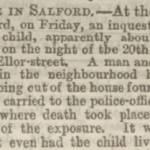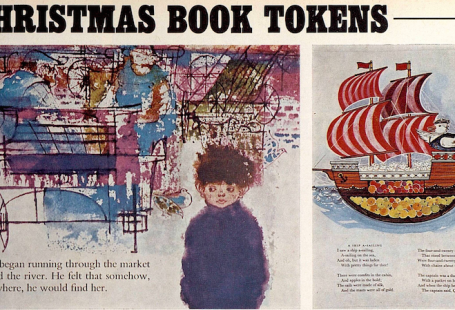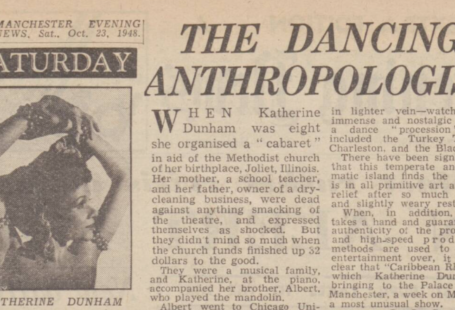In December, 1811, all London was convulsed with terror at the tidings of the horrible slaughter wreaked at 29 Ratcliff Highway and 81 New Gravel Lane, and soon, from the Prince Regent’s table at Carlton House to the tap-room of the lowest dram-shop in Wapping, the hideous subject engrossed all.
Ally Sloper’s Half Holiday, 27 August 1887
These murders, now generally referred to as the Ratcliff Highway Murders, represent one of the bloodiest chapters in British crime history, and might have been the crime of the nineteenth century, had not another series of murders taken place some seventy years later nearby.
And the Ratcliff Highway Murders, like the Jack the Ripper killings, were notable for the frenzy they caused amongst the local, and indeed, national population. So in this special blog, we will explore how the press of the day reported on the crimes, and understand the fear and the hysteria that led to the apprehension of multiple suspects.
Want to learn more? Register now and explore The Archive
‘Horrid Murders!’
On 16 December 1811 the Sussex Advertiser ran the headline ‘Horrid Murders!!!‘ The multiple exclamation marks immediately alert the reader as to the barbarity of the crimes, and this was the tone of the majority of the press, as news of the murder of the Marr family on 7 December 1811 spread.
Timothy Marr, who was in his twenties, ran a silk mercer’s shop at 29 Ratcliffe Highway, where he lived with his wife Celia, their three-month-old son, also Timothy, his apprentice James Gowan and their servant Margaret Jewell.
Sussex Advertiser | 16 December 1811
On the night of the murders, Margaret had been sent out to buy oysters. The Sussex Advertiser reports how it was late on Saturday evening when she was dispatched on her errand, ‘about twelve o’clock,’ and she left ‘her mistress suckling her child…and her master employed behind the counter, arranging his goods preparatory to closing the shop.’
Returning about half an hour later, having been unable to buy the oysters, Margaret found ‘the shop shut up, and the door fastened.’ Ringing ‘violently at the bell,’ no one answered, and instead the attention of a nearby watchman was gained.
The Sussex Advertiser then relates how a neighbour, Mr. Murray, a pawnbroker, was roused by the watchman, and it was he who gained entrance to the house. The Sussex Advertiser spares no detail in the scene that was to meet Mr. Murray inside:
…he was attracted by a light on the landing-place; he took the light, and the first horrid spectacle was the apprentice boy, James Goen, about fourteen years of age, lying on his face, at the farther part of the shop, with his brains knocked out, part of them actually covering the ceiling, and blood on the wall and counter.
Mrs Celia Marr was the next victim to be discovered, ‘lying on the floor dreadfully wounded and lifeless.’ Her husband Timothy was found behind the counter in the shop, ‘bleeding, profusely about the head, with no signs of life.’ And tragically, the couple’s young son was found dead in his cradle in the kitchen.

Strangely enough, as the Sussex Advertiser reports, ‘152l in cash and notes was found in a tin box,’ so it looked like robbery was not the motive for the brutal killings, or perhaps the return of Margaret had disturbed the murderers before they had had a chance to rob the house. It was guessed that ‘these horrid murders must have been committed in about twenty minutes.’
An inquest was held two days later at the Jolly Sailors’ public house, also on Ratcliff Highway, where the jury returned a verdict of ‘Wilful Murder, against some person or persons unknown, on each of the bodies.’
The Sussex Advertiser records a further tragic detail. Celia Marr’s mother and two of her sisters had come ‘from the country intending to dine with her on the Sunday, and did not hear of the dreadful destruction of their relatives until they reached the house.’ One can only imagine their shock and sorrow.
‘Another Most Dreadful Murder!’
On 20 December 1811, the Star (London) wrote:
It is our melancholy duty to record another most woeful calamity, in which a whole family has been again most savagely butchered!
A second attack had taken place The King’s Arms tavern, on New Gravel Lane, close to Ratcliff Highway. Its victims were 56-year-old publican John Williamson and his wife, sixty-year-old Elizabeth Williamson. Also found dead was their servant, Bridget Anna Harrington, who was in her fifties.
Star (London) | 20 December 1811
Taking place twelve days later after the murder of the Marrs and their apprentice, the press were already quick to make a link between the two brutal crimes, the Star (London) reporting how ‘The general conjecture at present is that the murderers are the same desperados who assassinated Mr. Marr and his family.’
The Chester Courant, 24 December 1811, contains further detail on the ‘horrid transaction,’ which took place ‘between eleven and twelve o’clock…within a very short distance of the house of the late Mr. Marr.’
The newspaper relates how the crime was discovered:
At the hour we have mentioned, the neighbours on the opposite side of Gravel-lane, were alarmed by a cry of ‘Murder!’ from a person named Turner, in his shirt, who was descending from a two-pair-of-stairs window, by the sheets of his bed tied together. On his reaching the bottom, he informed those who were assembled, that murderers were in the house, committing dreadful acts of bloodshed on the whole family.
Turner was a lodger in the house, and other accounts have him escaping without any clothes at all. Meanwhile, the ‘alarm was instantly given,’ with a constable named Anderson and two other ‘resolute men,’ Ludgate and Hawse, arming themselves and entering the house. ‘Horrid to relate, they found the master and the mistress of the house, and the servant-maid, Biddy…lying quite dead, their throats cut from ear to ear.’
Chester Courant | 24 December 1811
Fortuitously, the fourteen-year-old granddaughter of the landlord, ‘who slept in the upper part of the house,’ was completely unharmed.
The Chester Courant, furthermore, tells of how Mr. Anderson, a butcher and neighbour of the Williamsons, realised something was wrong. He had been intending to collect a pot of beer from The King’s Arms, but having seen Turner escaping from the window, he ‘then ran into his own house for his sword and staff,’ whilst Turner was caught by the the watchman.
Anderson, accompanied by the other men, then entered the house via the cellar, and soon found ‘Mr. Williamson lying on his back with his legs upon the stairs, his head downwards.’ The Chester Courant tells of how by his side was ‘an iron instrument, similar to a stone mason’s crow, about three feet long…much stained with blood.’ It was supposed that Mr. Williamson had made ‘great resistance’ to his attackers, ‘being a very powerful man.’

Escape of John Turner from the Williamsons’s home
Meanwhile, Mrs. Williamson was found in the sitting room, with a fractured skull. Her throat, like her husband’s, had also been cut. The body of Bridget, the servant, was found in the same room, and it was ‘supposed that she had been killed while in the act of laying the fire for the following morning.’ Her throat was cut, ‘most inhumanly,’ too.
It was supposed that the murder or murderers had been disturbed by Turner’s raising the alarm, and like at the Marrs’s, had made a quick getaway.
‘All of Wapping in Uproar’
After the discovery of this second attack, the Star (London), 20 December 1811, relates how:
All Wapping was immediately in uproar. The drums of the Volunteers beat to arms, the fire-bells were rung, and every person flew in consternation to the spot. The Police searched every house around, and every boat in the river, with every cart, waggon, and carriage was stopped.
Star (London) | 20 December 1811
The first attack had already shaken the East End, the Sussex Advertiser labelling it ‘an horrid and afflicting event,’ the Nottingham Journal on the 14 December reporting on the ‘Horrible Murder of a Whole Family.’
Horrid, dreadful, barbarous, these were the words constantly in use, because these crimes were wholly horrid, dreadful and barbarous, without apparent cause or motive. It is little wonder then that popular feeling had reached a fever pitch, the flames only fuelled by the second violent attack.
Nottingham Journal | 14 December 1811
Some seventy years later, the Sheffield Evening Telegraph likens the ‘excitement‘ caused by the Ratcliff Highway murders to the Whitechapel murders, the crimes of Jack the Ripper. The article contains contemporary testimony from essayist Thomas De Quincey, who wrote regarding the Ratcliff Highway murders:
It would be absolutely impossible to adequately describe the frenzy of feelings which, throughout the next fortnight, mastered the popular heart; the mere indignant horror in some, the mere delirium of panic in others.
Sheffield Evening Telegraph | 13 September 1888
The fear spread outwards from its London epicentre, as De Quincey describes:
For twelve succeeding days, under some groundless notion that the unknown murderer had quitted London, the panic which had convulsed the nightly Metropolis diffused itself all over the island. I was myself at that time nearly three hundred miles from London, but there, and everywhere, the panic was indescribable.
With the population of London and even the rest of Britain so disturbed, soon rewards were being demanded, so that the perpetrator or perpetrators could be brought to justice.
After the murder of the Marr family, the London Courier and Evening Gazette is demanding that the ‘Secretary of State for the Home Department…offer a reward from Government, in addition to those offered by the Parish and the Thames Police Office.’ The newspaper hopes this would ‘afford every means for the apprehension of these sanguinary offenders.’
The Sussex Advertiser reports how the reward offered by the Thames Police Office was 20l, with 50l ‘already advertised by St. George’s parish.’ And by 21 December 1811, this notice appeared in the Westmorland Advertiser and Kendal Chronicle:
…His Royal Highness [the Prince Regent], for the better apprehending and bringing to justice the persons concerned in the said atrocious murders, is hereby pleased to offer a Reward of One Hundred Pounds to any one of them (except the person or persons who actually perpetrated the said murders), who shall discover his or their accomplice or accomplices therein, to be paid on the conviction of any one or more of the offenders, by the Right Honourable the Lords Commissioners of his Majesty’s Treasury.
Westmorland Advertiser and Kendal Chronicle | 21 December 1811
Public feeling was further stirred by the moving funeral of the Marr family. The Westmorland Advertiser and Kendal Chronicle describes the ‘scene of sorrow and lamentation,’ as crowds gathered outside St. George’s Church:
No language can explain the grief depicted in every countenance on witnessing the coffins containing the unfortunate bodies of Mr. Marr, Mrs. Marr, and her infant. The affliction of the aged parents, the brother and sisters of the deceased was the most heart-rending spectacle.
And even a month later, Bell’s Weekly Messenger on 19 January 1812 reports how ‘The public mind continues naturally alive to every farther search and discovery respecting the late horrible murders.’
‘Every Foreign Villain’
It is no surprise, then, that with the sensation that the murders caused, that every vaguely suspicious person was regarded as the culprit of the terrible crimes.
Unfortunately, this highlighted the xenophobia at play in the country at the time. The Sussex Advertiser writes how it has ‘been generally reported that the perpetrators are foreigners.’ Meanwhile, the Star (London) states how ‘it is asserted that both atrocities have been perpetrated by foreigners,’ continuing:
We trust, therefore, that every foreign villain, of whatever rank or degree, throughout the country, will be instantly taken into custody, and kept as hostages for the security of the lives of his Majesty’s subjects.
Star (London) | 20 December 1811
With the Star (London) requesting that every foreigner be thrown in prison for the crimes, it was no surprise that ‘Three Portuguese sailors…were taken up on suspicion,’ as reports the Sussex Advertiser. These three Portuguese men consistently found themselves accused of the crime, as the Kentish Gazette reports on 3 January 1812:
Monday the three Portuguese, who have been frequently examined on suspicion of being concerned in the murder of Mr. Marr’s family on the 8th ult. were again brought up. The charges of suspicion were abandoned, but the Magistrates ordered them to be confined, in consequence of their being at large without a passport, until they could satisfactorily account for their conduct.
But it was not just foreigners who found themselves accused. As the Star (London) reports, ‘A great number of suspicious characters have…been stopped.’ This included one Thomas Knight, as the Oxford Journal details, ‘who underwent another long and minute examination.’
Oxford Journal | 21 December 1811
Also taken up was an ‘invalid boatswain,’ as the Oxford Journal reports. He had claimed that ‘seven men were employed to commit the murder by a near relative to the deceased,’ Timothy Marr, but upon being questioned he maintained that:
… he had a fractured skull, and when he got drunk he did not know what he said; declared he knew nothing of the murder, and he was sorry he had used such shocking words.
The Kentish Gazette, 31 December 1811, detailed yet more suspects. Sylvester Dryscoll was arrested because some ‘bloody breeches [were] found in his possession.’ A groom named Anthony Aldmond was taken into custody because:
…he had taken a bundle of clothes to a washerwoman to be washed, consisting of a shirt covered about the neck with blood, and also a handkerchief, waistcoat, and small clothes in the same state.
Meanwhile, one Mary Williams, according to the Kentish Gazette, 3 January 1812, was ‘lodged in the Poultry Compter,’ having been found in Billingsgate, ‘walking the streets in a state of intoxication, her clothes and person much stained with blood.’ The account of herself she gave was not satisfactory, and she was arrested.
And yet, the main suspect was John Williams, alias Murphy, who would not live to defend himself.
John Williams – Felon of Himself
John Williams became a main suspect in the case after the maul that had been used in the Marr family murder was linked to a sailor who lodged at the Pear Tree Inn, where Williams also stayed. He had the opportunity to take the maul, whilst his behaviour after the murders was seen as suspicious, and his clothing was reported to be torn and bloody.
And so John Williams was taken into custody. The Kentish Gazette, 31 December 1811, reports on what happened next:
…the second examination of John Williams, suspected of being the murderer of Marr’s and Williamsons’s families, was expected to take place at eleven o’clock. At half past nine, the proper officer was dispatched to the New Prison, in order to bring the prisoner in safe custody.
The Magistrates assembled soon after ten, accompanied by Mr. Reader, and several other Gentlemen. They were then informed that Williams had committed suicide.

The maul that was used in the first killings
And although John Williams had taken his own life, witnesses were still called against him. His landlady at the Pear Tree Inn, Mrs Vermilloe, testified how she had seen ‘the marks of two bloody fingers’ upon the accused’s stockings. It was, however, the discovery of the ‘maul…that made her suspect Williams of the murder of the Marr family.’ Mrs Vermilloe then set about watching her lodger carefully:
Williams was in the habit of wearing very large whiskers, and Saturday night last was the first time she perceived that he had cut them off. After that period she closely watched him, and she thought he seemed to be afraid to look at her. The subject of the two murders was often mentioned in his company, and though before very talkative, she observed that Williams always slank out of the way, into the passage, and seemed to be listening to what was said. One day it was remarked to him, that Williamsons’s was a very shocking affair. ‘Yes,’ said he, ‘very shocking,’ and he then turned off the conversation.
A man named Cuthbert, who shared a room with Williams, also attested to Williams suffering nightmares after the murder, and to his talking in his sleep. One outburst, according to the Kentish Gazette, recorded the accused as saying ‘Five shillings! – why my pockets are full of shillings!’
The Kentish Gazette also gives a full account of the discovery of Williams’s suicide. He was discovered by Coldbath Fields Prison turnkey Joseph Becket on 28 December 1811 ‘between seven and eight [in the] morning, with a white handkerchief around his neck,’ and with the help of other inmates, Becket cut him down.
Gateway of Coldbath Fields Prison | The Sphere | 12 January 1901
Prison surgeon Thomas Webb declared Williams dead, stating that he had ‘no doubt [that] he died from strangulation.’ However, Williams had told Webb two days before he died that he ‘was perfectly easy and satisfied.’ Fellow prisoner Francis Knott, who had helped to cut Williams down concurred, saying that he ‘had no suspicion of any thing of the kind happening,’ and how Williams had been ‘quite rational and collected’ when the two spoke.
Turnkey Joseph Becket, however, provided some interesting testimony when he reported how Williams had told him that ‘he hoped the innocent would not suffer, and the saddle might be placed on the right horse.’
Williams may well have been innocent of the crimes, but contemporary society took his suicide as tantamount to an admission of guilt, suicide at the time being both a taboo, and a crime. At the inquest into Williams’s death, Mr. Unwin the coroner addressed the jury in the following terms, as reported in the Kentish Gazette:
…how much augmented is the suspicion of guilt against a man, who to escape justice, has recourse to self-destruction! All homicide is murder till the contrary shall be shewn. The law ranks the suicide in the worst class of murderers, and this is a case of unqualified self-murder.
Williams, via his final desperate act, had essentially condemned himself, leaving the coroner Unwin to ‘consign the body of this self-murderer to that infamy, and disgrace which the law has prescribed.’ A verdict of felo de se – felon of himself – was given. Tellingly, Mr. Atkins, ‘the keeper of the prison, was so indisposed,’ that he could not attend the inquest.
Weeks after Williams’s suicide, Bell’s Weekly Messenger reports how an ‘important discovery’ had been made, which removed ‘every shadow of doubt respecting’ Williams’s guilt. Williams had been seen in possession of a ‘long French knife with an ivory handle’ before the murder of the Williamsons and their maid, which had never been found in his belongings.
However, one Harrison, a lodger at the Pear Tree Inn, found the bloodstained knife in the pocket of a blue jacket belonging to Williams. A search of the mousehole in the room also revealed ‘the handle of clasp-knife, apparently dyed with blood.’ For many, this was the irresistible proof they had needed, that the right man had been arrested, and he now lay beneath the ground, unable to enact further terrors.
‘A Universal Yell of Loathing’
On 27 August 1887, the eccentric illustrated publication Ally Sloper’s Half Holiday published an article entitled ‘The Ratcliff Highway Murders,’ describing how:
In excavating a trench last year in St. George’s-in-the-East, for the purpose of laying a main for the Commercial Gas Company, the workmen, at a depth of six feet from the surface, found the skeleton of a man with a stake driven through it. These remains were undoubtedly those of John Williams, in life greeted with a universal yell of loathing and execration.
For John Williams, guilty or innocent, was not to rest easy in death. His burial was just about as brutal as the murders he was suspect of committing, a barbarous end to a barbarous set of crimes.
Taken from Coldbath Fields Prison, his body was placed on a cart, the iron he wore in prison still attached to his leg, the ‘fatal maul placed on the left side of his head.’ Accompanied by a procession of three hundred constables, the morbid assembly travelled to the Marr family house, and thence to the Williamsons’s:
After standing another quarter of an hour in front of the house where the other three murders were committed, the procession proceeded to the spot where a hole had been dug, and the body was thrown into the infamous grave, amidst the acclamations of thousands of spectators. The stake, which the law required to be driven through the corpse, was with the maul driven through it. The grave was then filled with quicklime and covered up.
And many, no doubt, breathed a heavy sigh of relief that the terror of the past month had come to an end. But little did the crowd know, that in 1888 terror would again return to the streets of the East End, as Jack the Ripper enacted the most notorious crimes in British history.
You can find out more about such crimes of the past by searching our Archive, discovering contemporary witness testimonies, reports of inquests and trials, and the impact that such crimes had upon society.


















